Critical Evaluation of Behaviorist Theory in Child Learning
VerifiedAdded on 2022/09/28
|8
|2183
|87
Essay
AI Summary
This essay critically evaluates the application of behaviorist theory in explaining child learning and development. It begins by defining behaviorism and its core principles, including stimulus-response relationships, and then explores the three main types of behavioral learning: classical conditioning, operant conditioning, and observational learning. The essay delves into how these concepts, such as positive and negative reinforcement and punishment, shape a child's behavior in various contexts, including the classroom and home environments. It discusses how behaviorist theory explains both speech production and comprehension in children, highlighting the role of reinforcement from various sources. Furthermore, it examines the practical implications of behaviorism, such as establishing rules and using verbal reinforcement, while also acknowledging its limitations, particularly in fostering creative thinking. The essay concludes by summarizing the key arguments, emphasizing the role of observable behavioral changes in the learning process and the impact of consequences on shaping and modifying behaviors. References to relevant research and theories are also included to support the arguments presented.
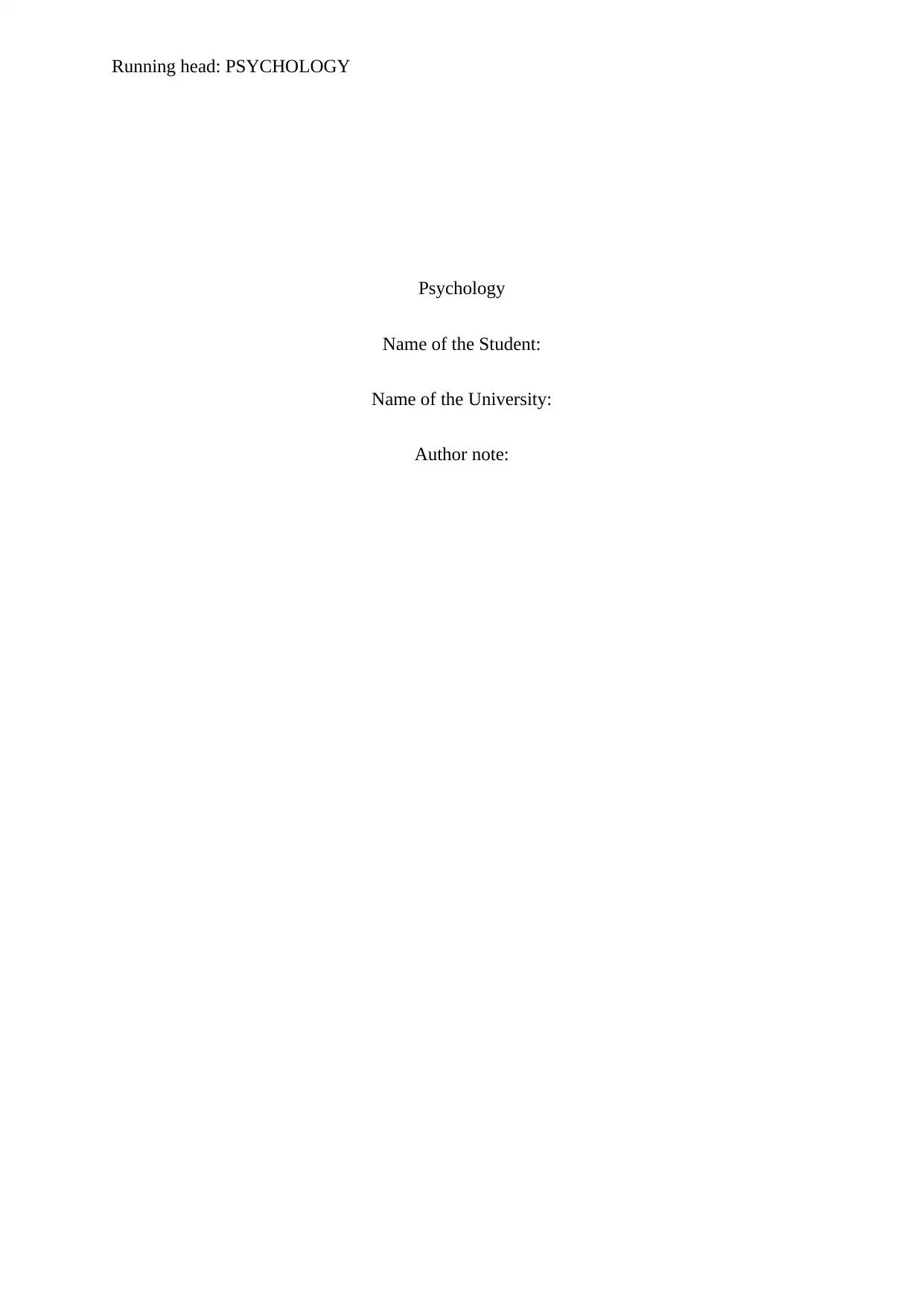
Running head: PSYCHOLOGY
Psychology
Name of the Student:
Name of the University:
Author note:
Psychology
Name of the Student:
Name of the University:
Author note:
Paraphrase This Document
Need a fresh take? Get an instant paraphrase of this document with our AI Paraphraser
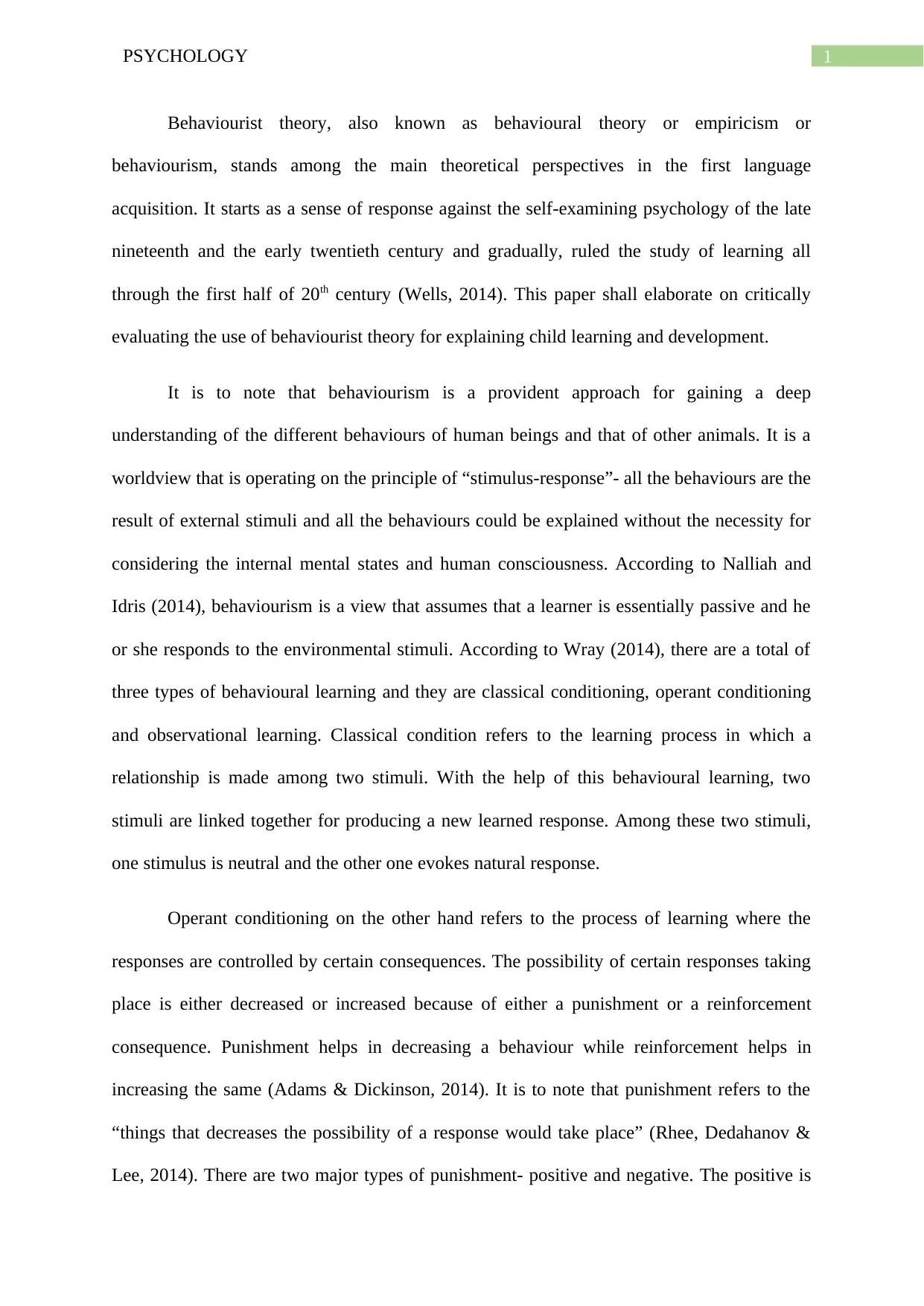
1PSYCHOLOGY
Behaviourist theory, also known as behavioural theory or empiricism or
behaviourism, stands among the main theoretical perspectives in the first language
acquisition. It starts as a sense of response against the self-examining psychology of the late
nineteenth and the early twentieth century and gradually, ruled the study of learning all
through the first half of 20th century (Wells, 2014). This paper shall elaborate on critically
evaluating the use of behaviourist theory for explaining child learning and development.
It is to note that behaviourism is a provident approach for gaining a deep
understanding of the different behaviours of human beings and that of other animals. It is a
worldview that is operating on the principle of “stimulus-response”- all the behaviours are the
result of external stimuli and all the behaviours could be explained without the necessity for
considering the internal mental states and human consciousness. According to Nalliah and
Idris (2014), behaviourism is a view that assumes that a learner is essentially passive and he
or she responds to the environmental stimuli. According to Wray (2014), there are a total of
three types of behavioural learning and they are classical conditioning, operant conditioning
and observational learning. Classical condition refers to the learning process in which a
relationship is made among two stimuli. With the help of this behavioural learning, two
stimuli are linked together for producing a new learned response. Among these two stimuli,
one stimulus is neutral and the other one evokes natural response.
Operant conditioning on the other hand refers to the process of learning where the
responses are controlled by certain consequences. The possibility of certain responses taking
place is either decreased or increased because of either a punishment or a reinforcement
consequence. Punishment helps in decreasing a behaviour while reinforcement helps in
increasing the same (Adams & Dickinson, 2014). It is to note that punishment refers to the
“things that decreases the possibility of a response would take place” (Rhee, Dedahanov &
Lee, 2014). There are two major types of punishment- positive and negative. The positive is
Behaviourist theory, also known as behavioural theory or empiricism or
behaviourism, stands among the main theoretical perspectives in the first language
acquisition. It starts as a sense of response against the self-examining psychology of the late
nineteenth and the early twentieth century and gradually, ruled the study of learning all
through the first half of 20th century (Wells, 2014). This paper shall elaborate on critically
evaluating the use of behaviourist theory for explaining child learning and development.
It is to note that behaviourism is a provident approach for gaining a deep
understanding of the different behaviours of human beings and that of other animals. It is a
worldview that is operating on the principle of “stimulus-response”- all the behaviours are the
result of external stimuli and all the behaviours could be explained without the necessity for
considering the internal mental states and human consciousness. According to Nalliah and
Idris (2014), behaviourism is a view that assumes that a learner is essentially passive and he
or she responds to the environmental stimuli. According to Wray (2014), there are a total of
three types of behavioural learning and they are classical conditioning, operant conditioning
and observational learning. Classical condition refers to the learning process in which a
relationship is made among two stimuli. With the help of this behavioural learning, two
stimuli are linked together for producing a new learned response. Among these two stimuli,
one stimulus is neutral and the other one evokes natural response.
Operant conditioning on the other hand refers to the process of learning where the
responses are controlled by certain consequences. The possibility of certain responses taking
place is either decreased or increased because of either a punishment or a reinforcement
consequence. Punishment helps in decreasing a behaviour while reinforcement helps in
increasing the same (Adams & Dickinson, 2014). It is to note that punishment refers to the
“things that decreases the possibility of a response would take place” (Rhee, Dedahanov &
Lee, 2014). There are two major types of punishment- positive and negative. The positive is
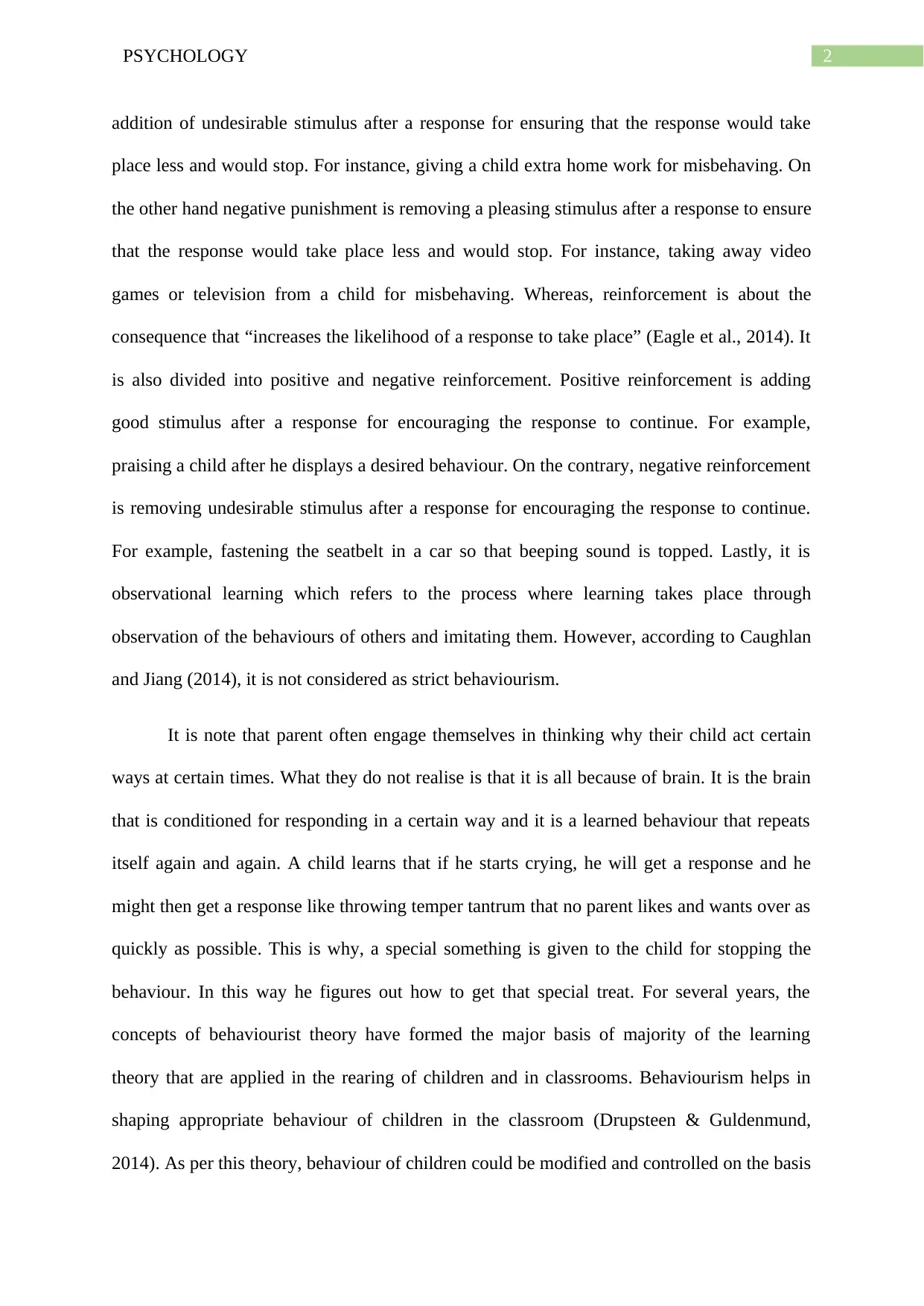
2PSYCHOLOGY
addition of undesirable stimulus after a response for ensuring that the response would take
place less and would stop. For instance, giving a child extra home work for misbehaving. On
the other hand negative punishment is removing a pleasing stimulus after a response to ensure
that the response would take place less and would stop. For instance, taking away video
games or television from a child for misbehaving. Whereas, reinforcement is about the
consequence that “increases the likelihood of a response to take place” (Eagle et al., 2014). It
is also divided into positive and negative reinforcement. Positive reinforcement is adding
good stimulus after a response for encouraging the response to continue. For example,
praising a child after he displays a desired behaviour. On the contrary, negative reinforcement
is removing undesirable stimulus after a response for encouraging the response to continue.
For example, fastening the seatbelt in a car so that beeping sound is topped. Lastly, it is
observational learning which refers to the process where learning takes place through
observation of the behaviours of others and imitating them. However, according to Caughlan
and Jiang (2014), it is not considered as strict behaviourism.
It is note that parent often engage themselves in thinking why their child act certain
ways at certain times. What they do not realise is that it is all because of brain. It is the brain
that is conditioned for responding in a certain way and it is a learned behaviour that repeats
itself again and again. A child learns that if he starts crying, he will get a response and he
might then get a response like throwing temper tantrum that no parent likes and wants over as
quickly as possible. This is why, a special something is given to the child for stopping the
behaviour. In this way he figures out how to get that special treat. For several years, the
concepts of behaviourist theory have formed the major basis of majority of the learning
theory that are applied in the rearing of children and in classrooms. Behaviourism helps in
shaping appropriate behaviour of children in the classroom (Drupsteen & Guldenmund,
2014). As per this theory, behaviour of children could be modified and controlled on the basis
addition of undesirable stimulus after a response for ensuring that the response would take
place less and would stop. For instance, giving a child extra home work for misbehaving. On
the other hand negative punishment is removing a pleasing stimulus after a response to ensure
that the response would take place less and would stop. For instance, taking away video
games or television from a child for misbehaving. Whereas, reinforcement is about the
consequence that “increases the likelihood of a response to take place” (Eagle et al., 2014). It
is also divided into positive and negative reinforcement. Positive reinforcement is adding
good stimulus after a response for encouraging the response to continue. For example,
praising a child after he displays a desired behaviour. On the contrary, negative reinforcement
is removing undesirable stimulus after a response for encouraging the response to continue.
For example, fastening the seatbelt in a car so that beeping sound is topped. Lastly, it is
observational learning which refers to the process where learning takes place through
observation of the behaviours of others and imitating them. However, according to Caughlan
and Jiang (2014), it is not considered as strict behaviourism.
It is note that parent often engage themselves in thinking why their child act certain
ways at certain times. What they do not realise is that it is all because of brain. It is the brain
that is conditioned for responding in a certain way and it is a learned behaviour that repeats
itself again and again. A child learns that if he starts crying, he will get a response and he
might then get a response like throwing temper tantrum that no parent likes and wants over as
quickly as possible. This is why, a special something is given to the child for stopping the
behaviour. In this way he figures out how to get that special treat. For several years, the
concepts of behaviourist theory have formed the major basis of majority of the learning
theory that are applied in the rearing of children and in classrooms. Behaviourism helps in
shaping appropriate behaviour of children in the classroom (Drupsteen & Guldenmund,
2014). As per this theory, behaviour of children could be modified and controlled on the basis
⊘ This is a preview!⊘
Do you want full access?
Subscribe today to unlock all pages.

Trusted by 1+ million students worldwide
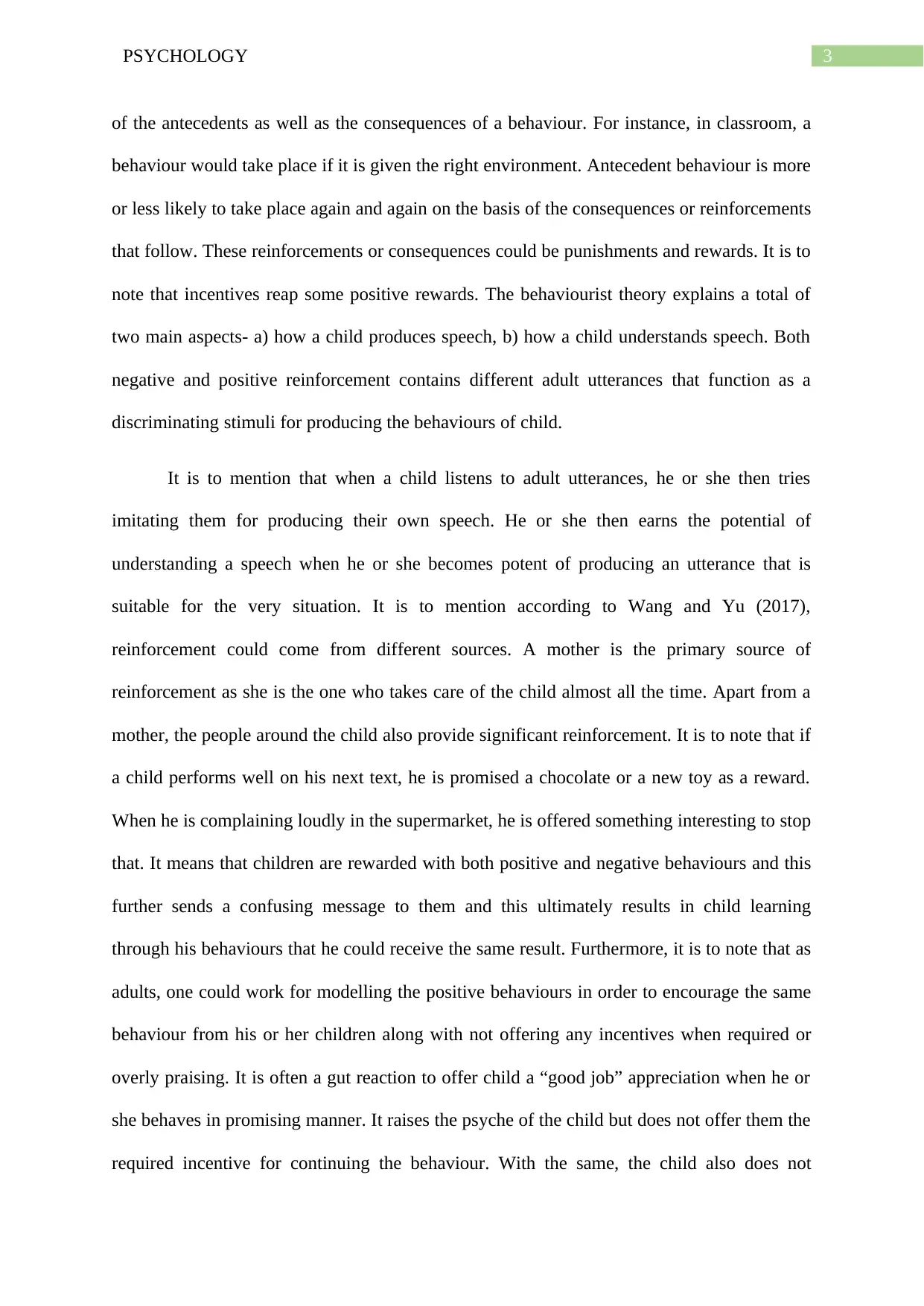
3PSYCHOLOGY
of the antecedents as well as the consequences of a behaviour. For instance, in classroom, a
behaviour would take place if it is given the right environment. Antecedent behaviour is more
or less likely to take place again and again on the basis of the consequences or reinforcements
that follow. These reinforcements or consequences could be punishments and rewards. It is to
note that incentives reap some positive rewards. The behaviourist theory explains a total of
two main aspects- a) how a child produces speech, b) how a child understands speech. Both
negative and positive reinforcement contains different adult utterances that function as a
discriminating stimuli for producing the behaviours of child.
It is to mention that when a child listens to adult utterances, he or she then tries
imitating them for producing their own speech. He or she then earns the potential of
understanding a speech when he or she becomes potent of producing an utterance that is
suitable for the very situation. It is to mention according to Wang and Yu (2017),
reinforcement could come from different sources. A mother is the primary source of
reinforcement as she is the one who takes care of the child almost all the time. Apart from a
mother, the people around the child also provide significant reinforcement. It is to note that if
a child performs well on his next text, he is promised a chocolate or a new toy as a reward.
When he is complaining loudly in the supermarket, he is offered something interesting to stop
that. It means that children are rewarded with both positive and negative behaviours and this
further sends a confusing message to them and this ultimately results in child learning
through his behaviours that he could receive the same result. Furthermore, it is to note that as
adults, one could work for modelling the positive behaviours in order to encourage the same
behaviour from his or her children along with not offering any incentives when required or
overly praising. It is often a gut reaction to offer child a “good job” appreciation when he or
she behaves in promising manner. It raises the psyche of the child but does not offer them the
required incentive for continuing the behaviour. With the same, the child also does not
of the antecedents as well as the consequences of a behaviour. For instance, in classroom, a
behaviour would take place if it is given the right environment. Antecedent behaviour is more
or less likely to take place again and again on the basis of the consequences or reinforcements
that follow. These reinforcements or consequences could be punishments and rewards. It is to
note that incentives reap some positive rewards. The behaviourist theory explains a total of
two main aspects- a) how a child produces speech, b) how a child understands speech. Both
negative and positive reinforcement contains different adult utterances that function as a
discriminating stimuli for producing the behaviours of child.
It is to mention that when a child listens to adult utterances, he or she then tries
imitating them for producing their own speech. He or she then earns the potential of
understanding a speech when he or she becomes potent of producing an utterance that is
suitable for the very situation. It is to mention according to Wang and Yu (2017),
reinforcement could come from different sources. A mother is the primary source of
reinforcement as she is the one who takes care of the child almost all the time. Apart from a
mother, the people around the child also provide significant reinforcement. It is to note that if
a child performs well on his next text, he is promised a chocolate or a new toy as a reward.
When he is complaining loudly in the supermarket, he is offered something interesting to stop
that. It means that children are rewarded with both positive and negative behaviours and this
further sends a confusing message to them and this ultimately results in child learning
through his behaviours that he could receive the same result. Furthermore, it is to note that as
adults, one could work for modelling the positive behaviours in order to encourage the same
behaviour from his or her children along with not offering any incentives when required or
overly praising. It is often a gut reaction to offer child a “good job” appreciation when he or
she behaves in promising manner. It raises the psyche of the child but does not offer them the
required incentive for continuing the behaviour. With the same, the child also does not
Paraphrase This Document
Need a fresh take? Get an instant paraphrase of this document with our AI Paraphraser
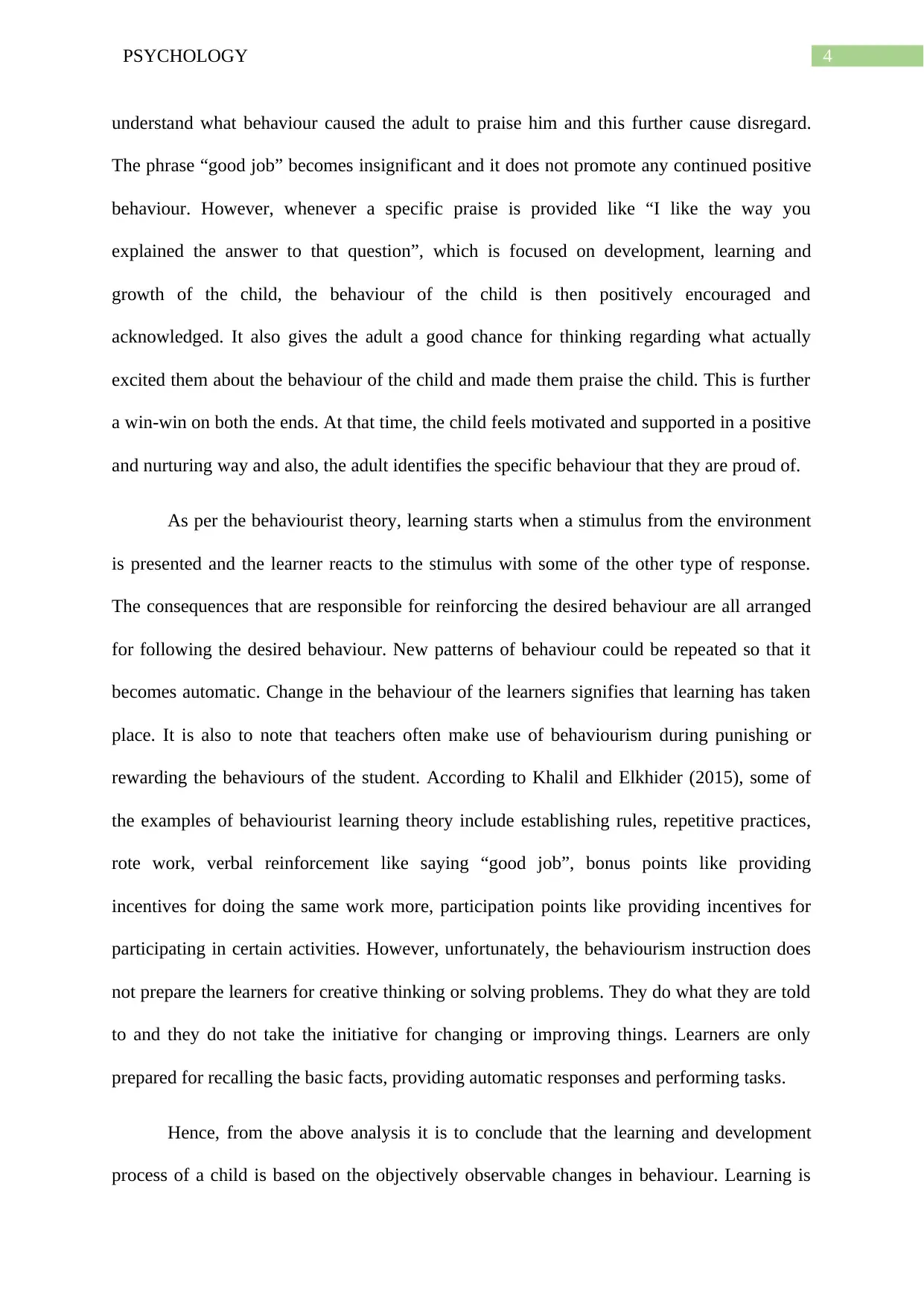
4PSYCHOLOGY
understand what behaviour caused the adult to praise him and this further cause disregard.
The phrase “good job” becomes insignificant and it does not promote any continued positive
behaviour. However, whenever a specific praise is provided like “I like the way you
explained the answer to that question”, which is focused on development, learning and
growth of the child, the behaviour of the child is then positively encouraged and
acknowledged. It also gives the adult a good chance for thinking regarding what actually
excited them about the behaviour of the child and made them praise the child. This is further
a win-win on both the ends. At that time, the child feels motivated and supported in a positive
and nurturing way and also, the adult identifies the specific behaviour that they are proud of.
As per the behaviourist theory, learning starts when a stimulus from the environment
is presented and the learner reacts to the stimulus with some of the other type of response.
The consequences that are responsible for reinforcing the desired behaviour are all arranged
for following the desired behaviour. New patterns of behaviour could be repeated so that it
becomes automatic. Change in the behaviour of the learners signifies that learning has taken
place. It is also to note that teachers often make use of behaviourism during punishing or
rewarding the behaviours of the student. According to Khalil and Elkhider (2015), some of
the examples of behaviourist learning theory include establishing rules, repetitive practices,
rote work, verbal reinforcement like saying “good job”, bonus points like providing
incentives for doing the same work more, participation points like providing incentives for
participating in certain activities. However, unfortunately, the behaviourism instruction does
not prepare the learners for creative thinking or solving problems. They do what they are told
to and they do not take the initiative for changing or improving things. Learners are only
prepared for recalling the basic facts, providing automatic responses and performing tasks.
Hence, from the above analysis it is to conclude that the learning and development
process of a child is based on the objectively observable changes in behaviour. Learning is
understand what behaviour caused the adult to praise him and this further cause disregard.
The phrase “good job” becomes insignificant and it does not promote any continued positive
behaviour. However, whenever a specific praise is provided like “I like the way you
explained the answer to that question”, which is focused on development, learning and
growth of the child, the behaviour of the child is then positively encouraged and
acknowledged. It also gives the adult a good chance for thinking regarding what actually
excited them about the behaviour of the child and made them praise the child. This is further
a win-win on both the ends. At that time, the child feels motivated and supported in a positive
and nurturing way and also, the adult identifies the specific behaviour that they are proud of.
As per the behaviourist theory, learning starts when a stimulus from the environment
is presented and the learner reacts to the stimulus with some of the other type of response.
The consequences that are responsible for reinforcing the desired behaviour are all arranged
for following the desired behaviour. New patterns of behaviour could be repeated so that it
becomes automatic. Change in the behaviour of the learners signifies that learning has taken
place. It is also to note that teachers often make use of behaviourism during punishing or
rewarding the behaviours of the student. According to Khalil and Elkhider (2015), some of
the examples of behaviourist learning theory include establishing rules, repetitive practices,
rote work, verbal reinforcement like saying “good job”, bonus points like providing
incentives for doing the same work more, participation points like providing incentives for
participating in certain activities. However, unfortunately, the behaviourism instruction does
not prepare the learners for creative thinking or solving problems. They do what they are told
to and they do not take the initiative for changing or improving things. Learners are only
prepared for recalling the basic facts, providing automatic responses and performing tasks.
Hence, from the above analysis it is to conclude that the learning and development
process of a child is based on the objectively observable changes in behaviour. Learning is
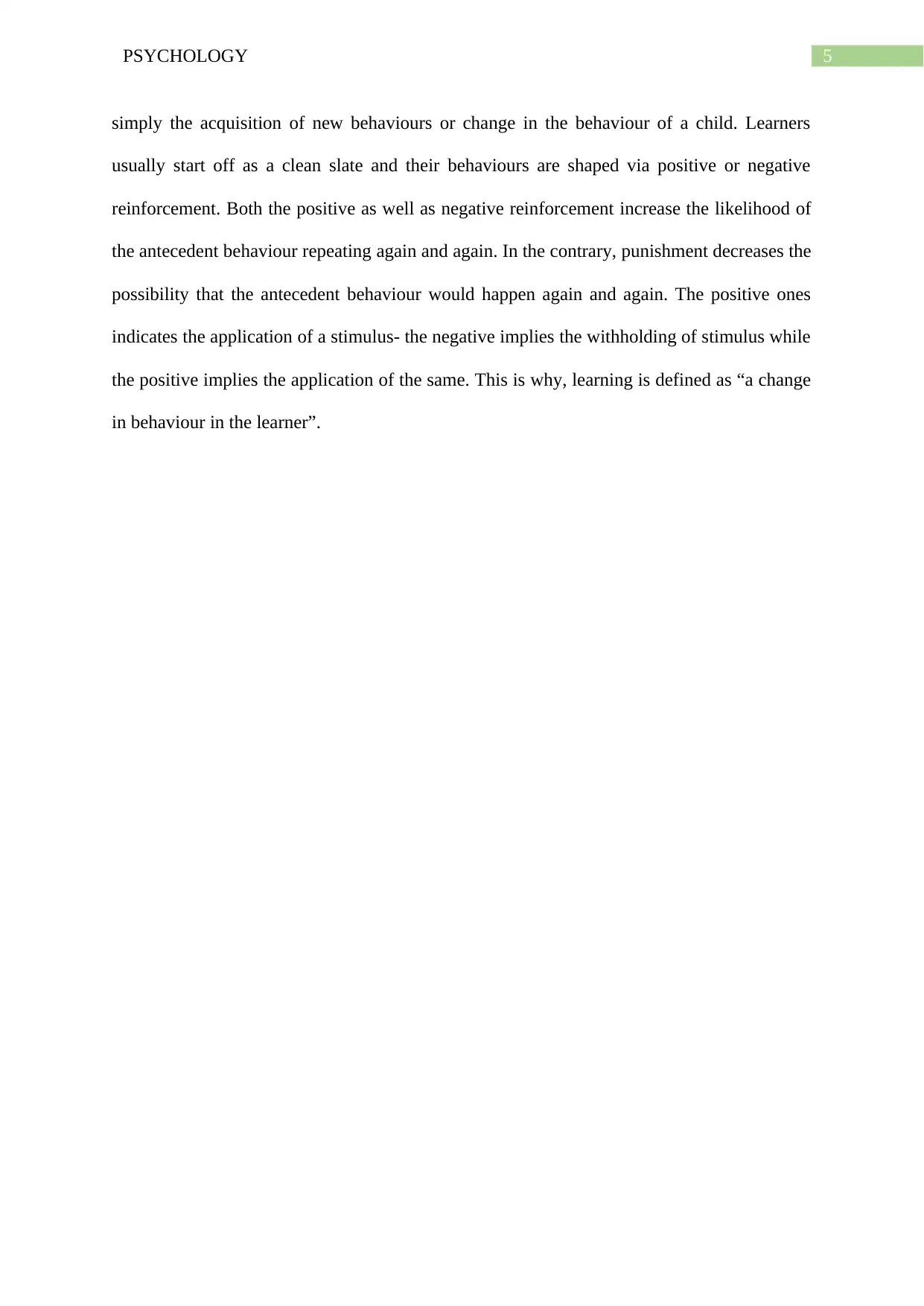
5PSYCHOLOGY
simply the acquisition of new behaviours or change in the behaviour of a child. Learners
usually start off as a clean slate and their behaviours are shaped via positive or negative
reinforcement. Both the positive as well as negative reinforcement increase the likelihood of
the antecedent behaviour repeating again and again. In the contrary, punishment decreases the
possibility that the antecedent behaviour would happen again and again. The positive ones
indicates the application of a stimulus- the negative implies the withholding of stimulus while
the positive implies the application of the same. This is why, learning is defined as “a change
in behaviour in the learner”.
simply the acquisition of new behaviours or change in the behaviour of a child. Learners
usually start off as a clean slate and their behaviours are shaped via positive or negative
reinforcement. Both the positive as well as negative reinforcement increase the likelihood of
the antecedent behaviour repeating again and again. In the contrary, punishment decreases the
possibility that the antecedent behaviour would happen again and again. The positive ones
indicates the application of a stimulus- the negative implies the withholding of stimulus while
the positive implies the application of the same. This is why, learning is defined as “a change
in behaviour in the learner”.
⊘ This is a preview!⊘
Do you want full access?
Subscribe today to unlock all pages.

Trusted by 1+ million students worldwide
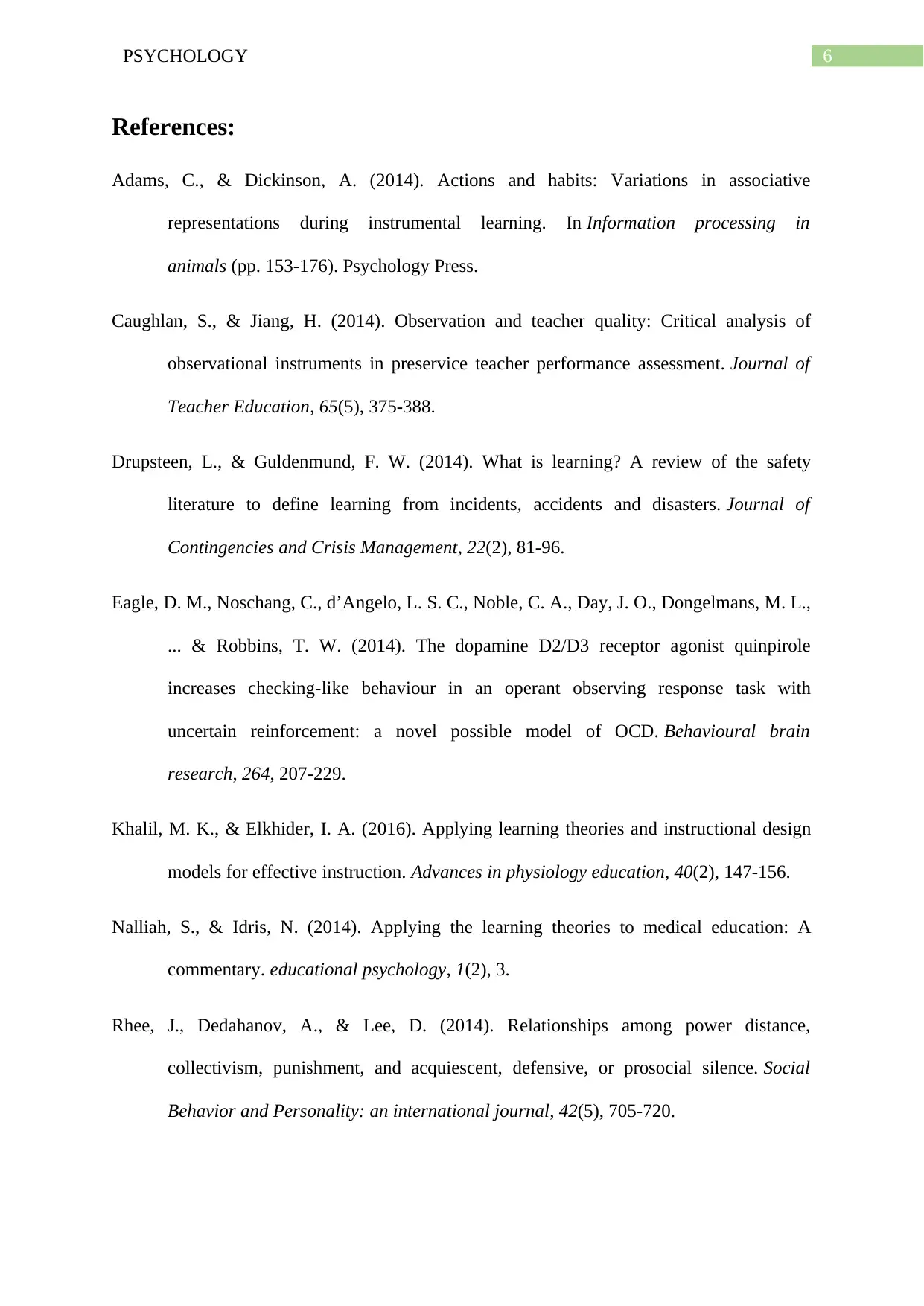
6PSYCHOLOGY
References:
Adams, C., & Dickinson, A. (2014). Actions and habits: Variations in associative
representations during instrumental learning. In Information processing in
animals (pp. 153-176). Psychology Press.
Caughlan, S., & Jiang, H. (2014). Observation and teacher quality: Critical analysis of
observational instruments in preservice teacher performance assessment. Journal of
Teacher Education, 65(5), 375-388.
Drupsteen, L., & Guldenmund, F. W. (2014). What is learning? A review of the safety
literature to define learning from incidents, accidents and disasters. Journal of
Contingencies and Crisis Management, 22(2), 81-96.
Eagle, D. M., Noschang, C., d’Angelo, L. S. C., Noble, C. A., Day, J. O., Dongelmans, M. L.,
... & Robbins, T. W. (2014). The dopamine D2/D3 receptor agonist quinpirole
increases checking-like behaviour in an operant observing response task with
uncertain reinforcement: a novel possible model of OCD. Behavioural brain
research, 264, 207-229.
Khalil, M. K., & Elkhider, I. A. (2016). Applying learning theories and instructional design
models for effective instruction. Advances in physiology education, 40(2), 147-156.
Nalliah, S., & Idris, N. (2014). Applying the learning theories to medical education: A
commentary. educational psychology, 1(2), 3.
Rhee, J., Dedahanov, A., & Lee, D. (2014). Relationships among power distance,
collectivism, punishment, and acquiescent, defensive, or prosocial silence. Social
Behavior and Personality: an international journal, 42(5), 705-720.
References:
Adams, C., & Dickinson, A. (2014). Actions and habits: Variations in associative
representations during instrumental learning. In Information processing in
animals (pp. 153-176). Psychology Press.
Caughlan, S., & Jiang, H. (2014). Observation and teacher quality: Critical analysis of
observational instruments in preservice teacher performance assessment. Journal of
Teacher Education, 65(5), 375-388.
Drupsteen, L., & Guldenmund, F. W. (2014). What is learning? A review of the safety
literature to define learning from incidents, accidents and disasters. Journal of
Contingencies and Crisis Management, 22(2), 81-96.
Eagle, D. M., Noschang, C., d’Angelo, L. S. C., Noble, C. A., Day, J. O., Dongelmans, M. L.,
... & Robbins, T. W. (2014). The dopamine D2/D3 receptor agonist quinpirole
increases checking-like behaviour in an operant observing response task with
uncertain reinforcement: a novel possible model of OCD. Behavioural brain
research, 264, 207-229.
Khalil, M. K., & Elkhider, I. A. (2016). Applying learning theories and instructional design
models for effective instruction. Advances in physiology education, 40(2), 147-156.
Nalliah, S., & Idris, N. (2014). Applying the learning theories to medical education: A
commentary. educational psychology, 1(2), 3.
Rhee, J., Dedahanov, A., & Lee, D. (2014). Relationships among power distance,
collectivism, punishment, and acquiescent, defensive, or prosocial silence. Social
Behavior and Personality: an international journal, 42(5), 705-720.
Paraphrase This Document
Need a fresh take? Get an instant paraphrase of this document with our AI Paraphraser
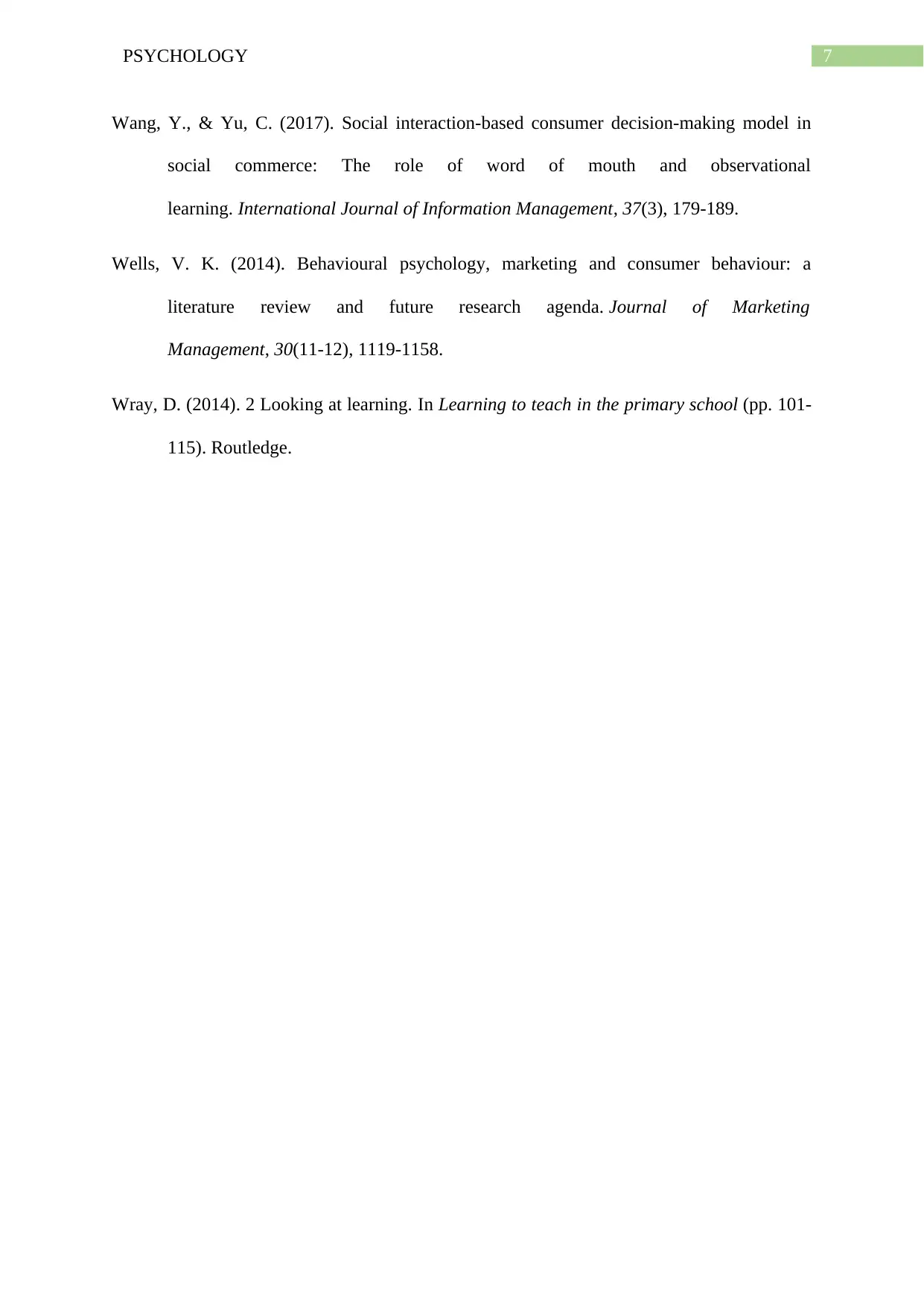
7PSYCHOLOGY
Wang, Y., & Yu, C. (2017). Social interaction-based consumer decision-making model in
social commerce: The role of word of mouth and observational
learning. International Journal of Information Management, 37(3), 179-189.
Wells, V. K. (2014). Behavioural psychology, marketing and consumer behaviour: a
literature review and future research agenda. Journal of Marketing
Management, 30(11-12), 1119-1158.
Wray, D. (2014). 2 Looking at learning. In Learning to teach in the primary school (pp. 101-
115). Routledge.
Wang, Y., & Yu, C. (2017). Social interaction-based consumer decision-making model in
social commerce: The role of word of mouth and observational
learning. International Journal of Information Management, 37(3), 179-189.
Wells, V. K. (2014). Behavioural psychology, marketing and consumer behaviour: a
literature review and future research agenda. Journal of Marketing
Management, 30(11-12), 1119-1158.
Wray, D. (2014). 2 Looking at learning. In Learning to teach in the primary school (pp. 101-
115). Routledge.
1 out of 8
Related Documents
Your All-in-One AI-Powered Toolkit for Academic Success.
+13062052269
info@desklib.com
Available 24*7 on WhatsApp / Email
![[object Object]](/_next/static/media/star-bottom.7253800d.svg)
Unlock your academic potential
Copyright © 2020–2025 A2Z Services. All Rights Reserved. Developed and managed by ZUCOL.





